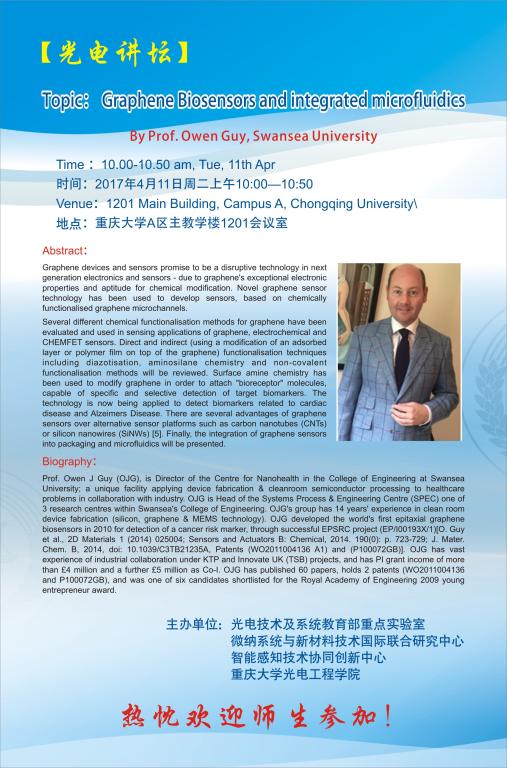Topic: Graphene Biosensors and integrated microfluidics
By Prof. Owen Guy, Swansea University
Time :10.00-10.50 am, Tue, 11th Apr(2017年4月11日周二上午10:00—10:50)
Venue:1201 Main Building, Campus A, Chongqing University(重庆大学A区主教学楼1201会议室)
Abstract:
Graphene devices and sensors promise to be a disruptive technology in next generation electronics and sensors - due to graphene’s exceptional electronic properties and aptitude for chemical modification. Novel graphene sensor technology has been used to develop sensors, based on chemically functionalised graphene microchannels.
Several different chemical functionalisation methods for graphene have been evaluated and used in sensing applications of graphene, electrochemical and CHEMFET sensors. Direct and indirect (using a modification of an adsorbed layer or polymer film on top of the graphene) functionalisation techniques including diazotisation, aminosilane chemistry and non-covalent functionalisation methods will be reviewed. Surface amine chemistry has been used to modify graphene in order to attach "bioreceptor" molecules, capable of specific and selective detection of target biomarkers. The technology is now being applied to detect biomarkers related to cardiac disease and Alzeimers Disease. There are several advantages of graphene sensors over alternative sensor platforms such as carbon nanotubes (CNTs) or silicon nanowires (SiNWs) [5]. Finally, the integration of graphene sensors into packaging and microfluidics will be presented.
Biography:
Prof. Owen J Guy (OJG), is Director of the Centre for Nanohealth in the College of Engineering at Swansea University; a unique facility applying device fabrication & cleanroom semiconductor processing to healthcare problems in collaboration with industry. OJG is Head of the Systems Process & Engineering Centre (SPEC) one of 3 research centres within Swansea’s College of Engineering. OJG’s group has 14 years’ experience in clean room device fabrication (silicon, graphene & MEMS technology). OJG developed the world’s first epitaxial graphene biosensors in 2010 for detection of a cancer risk marker, through successful EPSRC project (EP/I00193X/1)[O. Guy et al., 2D Materials 1 (2014) 025004; Sensors and Actuators B: Chemical, 2014. 190(0): p. 723-729; J. Mater. Chem. B, 2014, doi: 10.1039/C3TB21235A, Patents (WO2011004136 A1) and (P100072GB)]. OJG has vast experience of industrial collaboration under KTP and Innovate UK (TSB) projects, and has PI grant income of more than £4 million and a further £5 million as Co-I. OJG has published 60 papers, holds 2 patents (WO2011004136 and P100072GB), and was one of six candidates shortlisted for the Royal Academy of Engineering 2009 young entrepreneur award.
主办单位:光电技术及系统教育部重点实验室
微纳系统与新材料技术国际联合研究中心
智能感知技术协同创新中心
重庆大学光电工程学院

